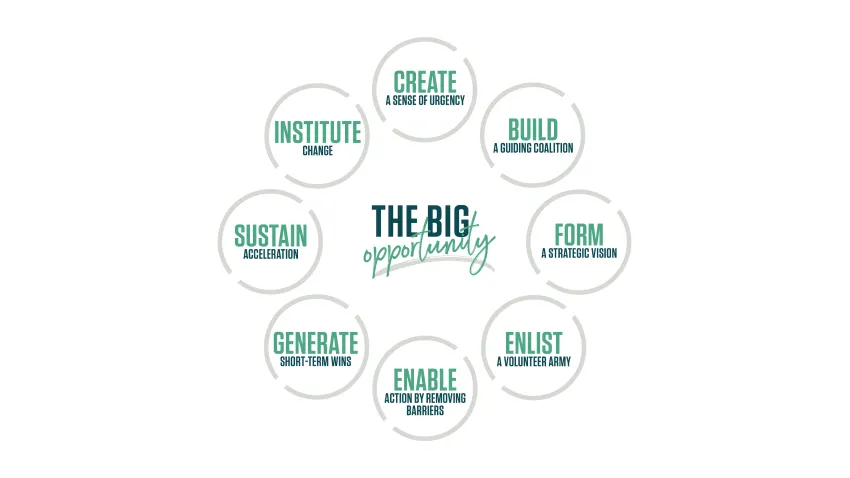Kotter’s 8-step change model was developed by Harvard Business School professor John P. Kotter in 1995.
This model provides a useful framework for implementing transformational and organizational change.
A seminal framework for leading transformation outlined by John P. Kotter in his book “Leading Change” 1996 explains the 8-step process organizations can follow to achieve large-scale change initiatives.
Each of the eight steps builds on each other to enable companies to achieve their change objectives.
Kotter’s 8-Step Change Model
- Create Urgency: Inspire people to move and address an imminent challenge or crisis
- Build a Guiding Coalition: Assemble an influential change leadership team with the power, credibility, connections, and expertise to drive change.
- Form Strategic Vision and Initiatives: Construct an uplifting vision and strategy to direct big-picture change
- Enlist Volunteers: Recruit an expanding wave of supporters to act as change leaders and promoters
- Enable Action and Overcome Obstacles: Provide the tools, systems, structures, and training needed to implement change
- Generate Short-Term Wins: Plan for, create, and promote visible performance improvements to sustain motivation
- Sustain Acceleration: Use credibility from early wins to implement bigger projects and expand the change vision
- Institute Change: Reinforce the changes to make them stick and embed them into organizational culture

Creating Urgency and Forming a Coalition
The first two steps in Kotter’s 8-Step Change Model focus on preparing the organization for change by creating a sense of urgency around the need for change and forming a powerful guiding coalition.
Assessing Threats and Opportunities
Conducting an honest assessment of the external and internal threats facing the organization is critical for motivating people about the need for change.
This assessment should include an analysis of competition, market forces, and evolving customer needs that present threats to the organization.
Building a Guiding Team
With urgency established, a strong guiding team driving the change needs to be formed.
This coalition of influential people from across the organization should have the credibility, skills, connections, and authority to lead the initiative.
Key Stakeholders and Influencers
Identifying key stakeholders and influencers across the organization and bringing them on board early on is important.
Their input, feedback, and eventual support reduce resistance.
Conducting stakeholder analysis to map out supporters, blockers, and neutrals guides strategy. Influential people can impact success.
Developing the Vision and Strategy
Defining core values is an important step in developing the vision and strategy for change.
The guiding coalition should determine the 3-5 core values that embody the future culture they want to create.
These values act as the foundation for decisions and actions going forward.
Communication and Overcoming Obstacles
Effective communication is vital for ensuring organizational change is understood and embraced by employees.
Leaders must communicate their vision and strategy, frequently, and through multiple channels to influence stakeholders.
Consistent and Persuasive Messaging
- Craft core messages that align with the vision and repeat them often
- Share success stories and progress to make the case for change
- Use multiple mediums like email, video, chat, and in-person forums
- Customize information for different audiences
Addressing Concerns and Resistance
- Anticipate objections and questions from those impacted
- Listen openly to understand the root causes of resistance
- Empathize with people’s perspectives and fears
Removing Barriers
- Identify visible barriers like outdated technology or policies
- Assess hidden barriers like lack of skills or incentives
- Allocate resources like training, tools, and coaching
The communication and change management process is iterative.
Leaders must continually assess sentiment, modify approaches based on feedback, and course-correct to overcome obstacles.
Short-term Wins and Building Momentum with Kotter’s 8-Step Change Model
It’s important to plan and execute some early, visible projects that can be implemented without too much effort and demonstrate progress.
These might be small process improvements, updated policies, or minor reorganizations that people will notice.
Quick wins build confidence in the change initiative and motivation to do more. They provide evidence that sacrifices and hard work are paying off.
After early projects are implemented, analyze the impact and results. Gather feedback from stakeholders, conduct audits or assessments, and determine what worked well and what needs improvement.
Quantify benefits when possible with metrics like time savings, revenue increases, and cost reductions. Publicize successes to the wider organization.
Anchoring the Changes
The final critical step with the 8-step change model is to anchor the changes into the organizational culture and systems so that they stick over the long term.
This involves several key components:
Integrating Change into Culture
- Identifying visible examples and success stories to showcase as part of the new culture
- Incorporating change narratives, values, and behaviors into onboarding processes
- Consistently communicating “why” behind the change to build understanding
Succession Planning and Onboarding
- Reviewing leadership pipeline and development plans for continuity
- Ensuring the next generation of leaders firmly grasp the organizational changes
- Designing onboarding curriculum and training programs to immerse new hires
- Recruiting and selecting candidates aligned with updated cultural values and priorities
Sustaining Over Long-term
- Tracking key metrics and KPIs related to change to spot regression
- Analyzing processes, systems, and technologies for barriers or gaps
- Establishing dedicated change leadership roles to sustain momentum
The goal is to thoroughly integrate the changes into the fabric of the organization – its culture, systems, and processes.
Applications Beyond Business
Kotter’s 8-step change model has broad applicability beyond just business organizations.
The framework for driving transformation can be applied to various settings:
- Education
- Politics
- Sports
Key Takeaways
While originally designed for corporations, Kotter’s 8-Step Change Model on leading organizational change presents a methodology adaptable to transformation initiatives in education systems, governments, athletic programs, and more.
The core framework of creating urgency, forming teams, developing strategies, enlisting buy-in, and anchoring the change can prove valuable across industries and roles.
Leaders of all types can borrow lessons from the 8-step change model approach when faced with the need for organizational reform.



